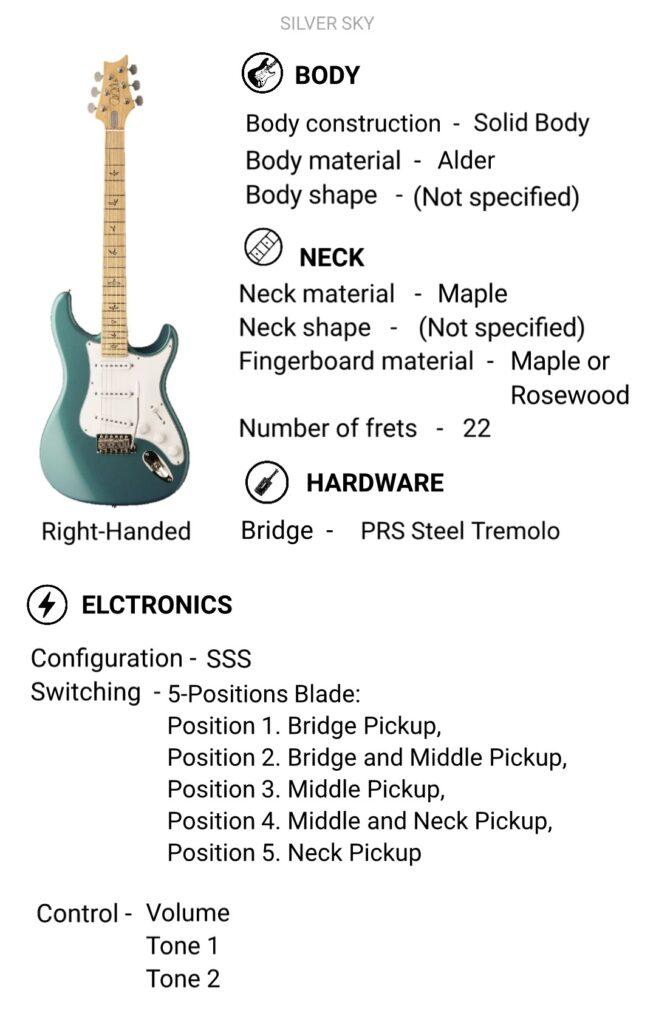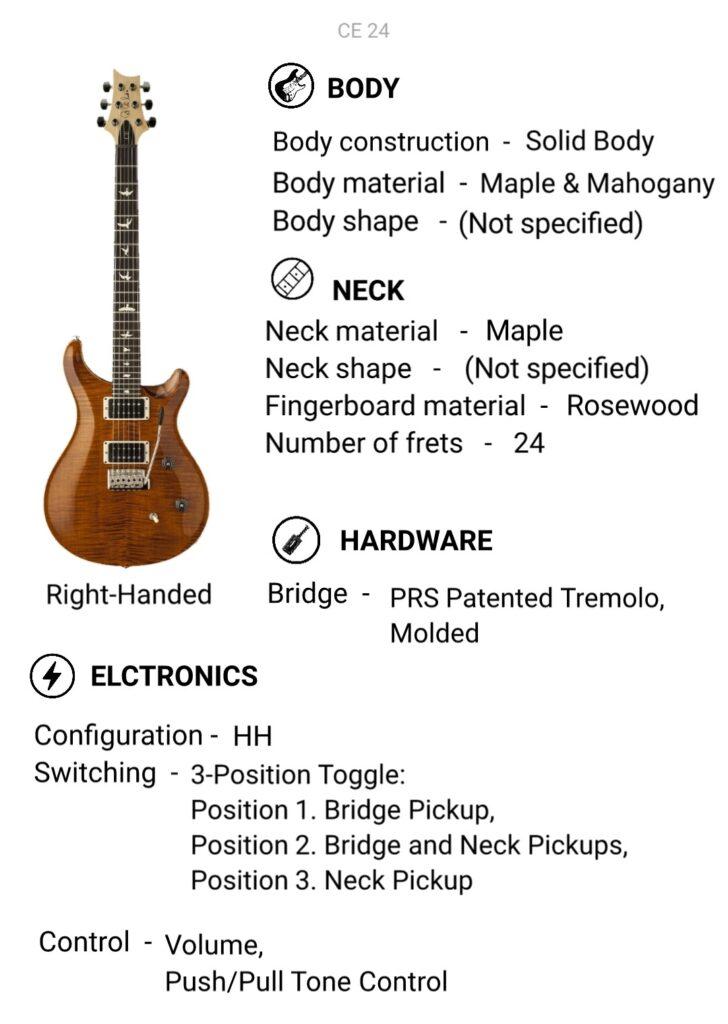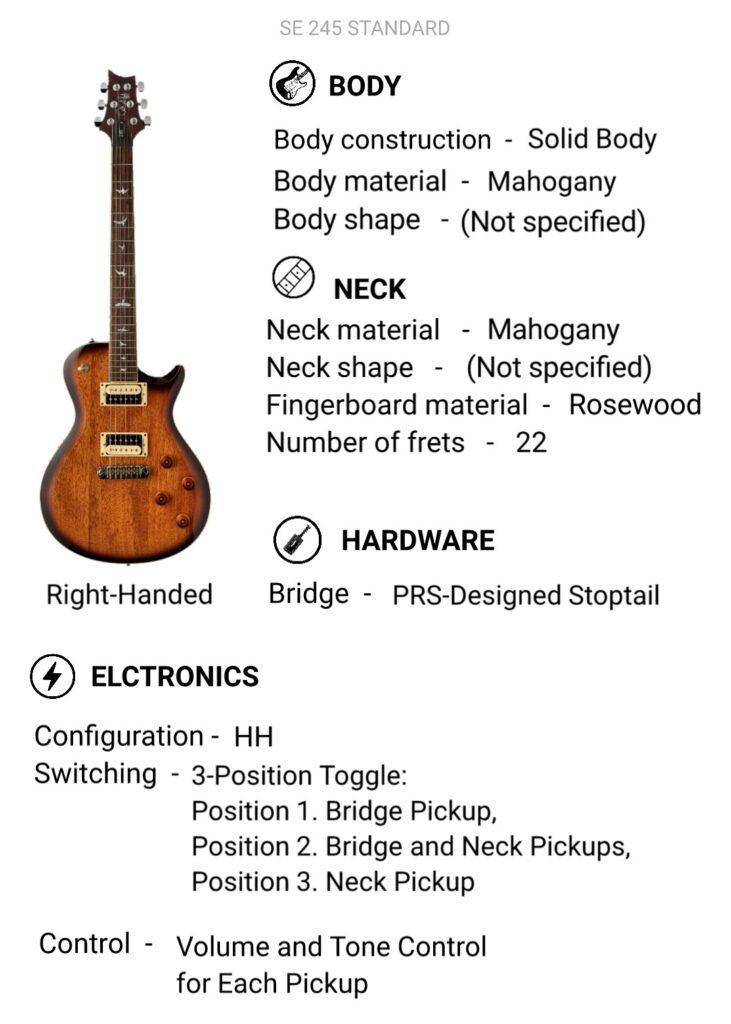list of all PRS electric guitars with prices, specifications and features from difference online
stores at infinicisum.net
PRS SE Standard 24-08
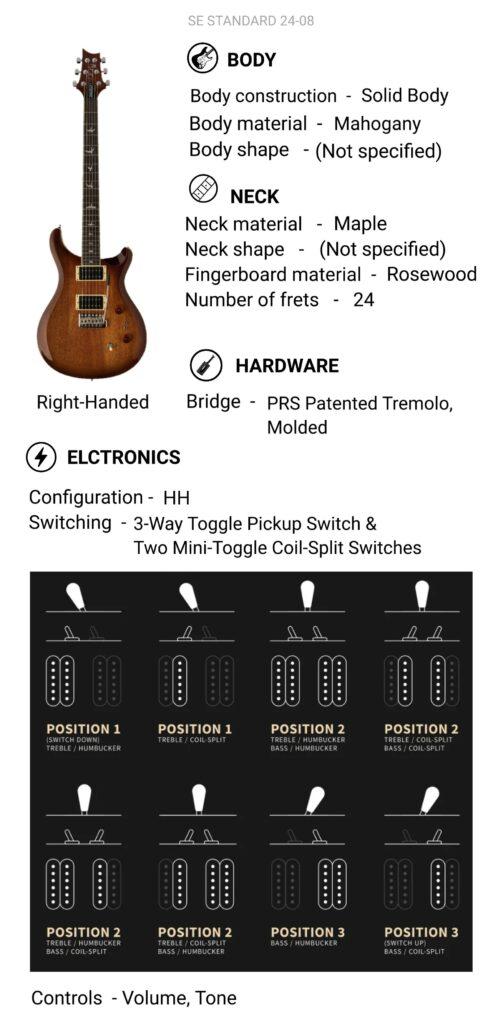
PRS SE Silver Sky
PRS CE 24 Semi-Hollow
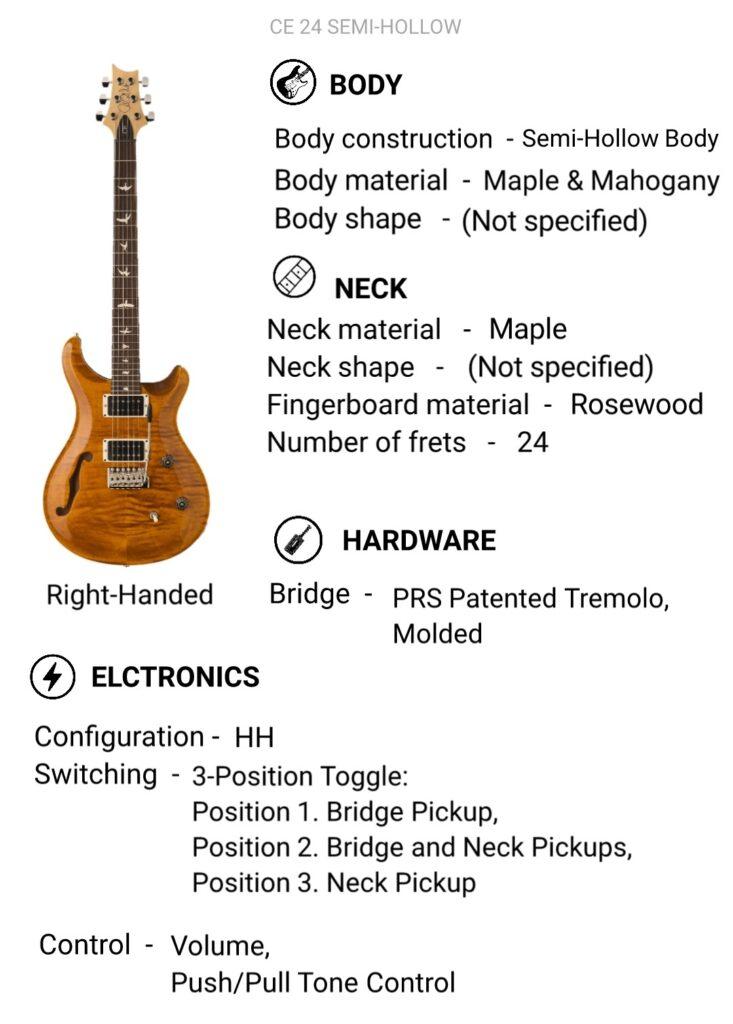
PRS SE Hollowbody II Piezo
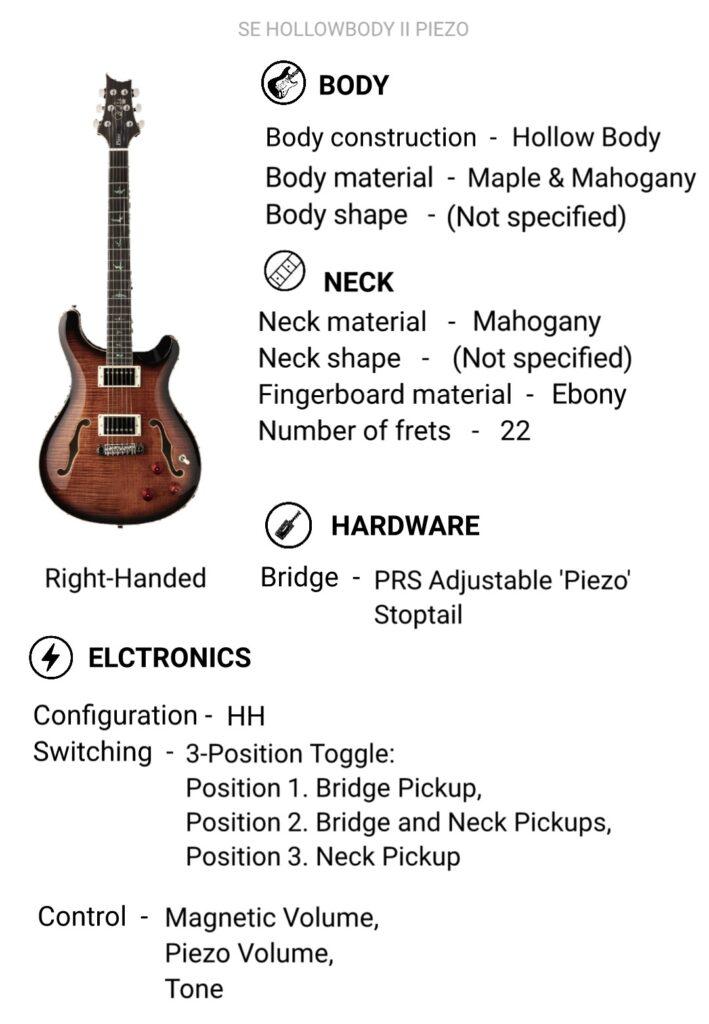
PRS S2 Mccarty 594

PRS SE Paul’s Guitar
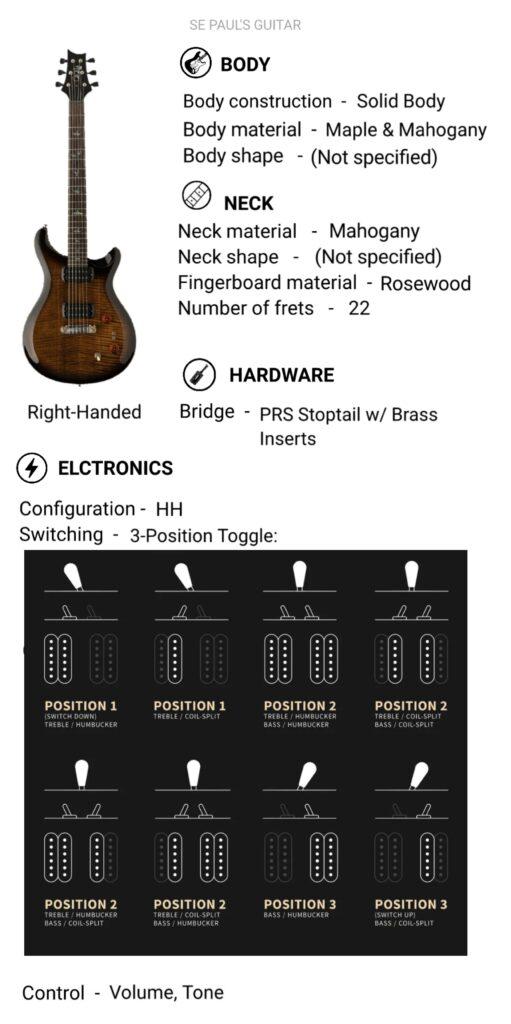
PRS SE Custom 22 Semi-Hollow
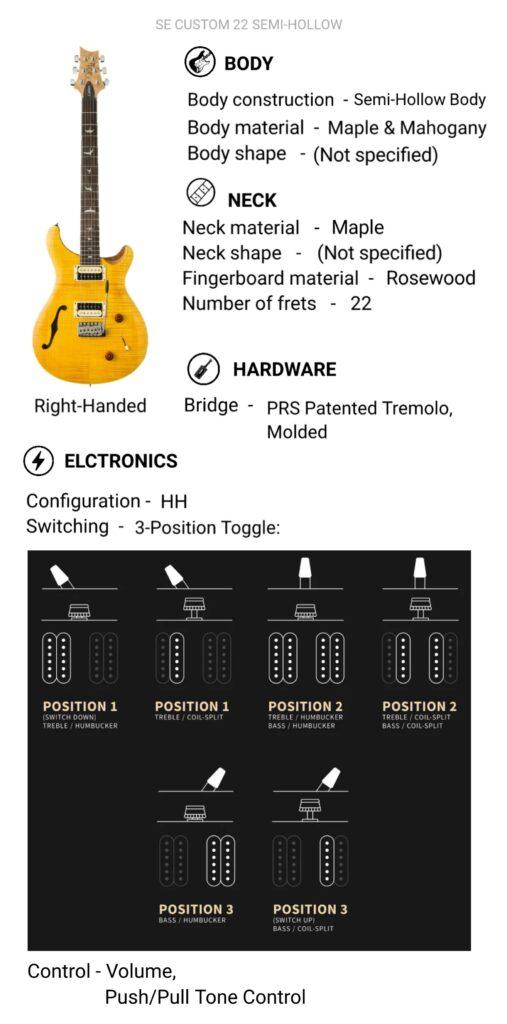
Introduction: Paul Reed Smith (PRS) electric guitars stand as a testament to the harmonious marriage of artistry and precision craftsmanship. From the Core Series to the SE models, PRS has carved out a distinctive space in the guitar world, offering instruments that appeal to a broad spectrum of players. Let’s delve into the enchanting world of PRS electric guitars.
”Read_More”
1. PRS Core Series:
- The Core Series represents the heart of PRS guitars, featuring high-end craftsmanship and a wide range of models. Known for exceptional playability and versatile tones, Core models are meticulously crafted with premium materials and attention to detail.
2. PRS S2 Series:
- The S2 Series combines PRS craftsmanship with more accessible pricing. S2 guitars are made in the United States and offer players a chance to experience PRS quality with a diverse lineup, including various body shapes, pickup configurations, and finishes.
3. PRS SE Series:
- The SE Series provides PRS quality at an entry to mid-level price point. Manufactured in Asia, these guitars deliver impressive value, featuring quality components, versatile tones, and a variety of signature models. SE guitars are suitable for players seeking affordability without compromising on performance.
4. PRS Private Stock:
- Private Stock represents the pinnacle of PRS craftsmanship, offering highly customized and limited-edition guitars. Built with rare tonewoods, intricate inlays, and meticulous attention to detail, Private Stock guitars are individually crafted to meet the unique specifications and preferences of each customer.
5. Limited Editions and Artist Models:
- PRS regularly releases limited-edition models and collaborates with artists to create signature guitars. These guitars often feature unique specifications, finishes, and electronics, allowing players to own instruments inspired by the preferences of renowned musicians.
6. PRS Bolt-On Series:
- The Bolt-On series from PRS features guitars with bolt-on neck construction, providing a different feel and tonal character compared to the set-neck designs commonly associated with PRS. These guitars often have a slimmer neck profile and are known for their crisp, articulate tones and enhanced bolt-on neck sustain.
In essence, PRS electric guitars embody a commitment to excellence, innovation, and sonic diversity. Whether you’re drawn to the timeless elegance of the Core Series, the accessibility of the S2 and SE models, or the bespoke luxury of Private Stock, PRS has crafted a comprehensive lineup that caters to the desires of players at every stage of their musical journey. The allure of PRS guitars lies not just in their technical prowess but in the inspiration they ignite in the hands of musicians across the globe.
How to choose Right PRS electric Guitar
Choosing the right PRS electric guitar involves considering various factors to ensure that the instrument aligns with your playing style, preferences, and budget. Here’s a guide to help you navigate the diverse range of PRS guitars:
1. Define Your Budget:
- Determine how much you are willing to invest in a PRS electric guitar. PRS offers guitars across a wide price range, from the more affordable SE Series to the high-end Private Stock. Having a budget in mind will help narrow down your options.
2. Identify Your Playing Style:
- Consider the genre or styles of music you primarily play. Different PRS models are designed with specific tones and playing styles in mind. Whether you’re into rock, metal, blues, or jazz, PRS offers guitars that cater to various genres.
3. Body Shape and Design:
- PRS guitars come in various body shapes, including the iconic Custom 24, Custom 22, Singlecut, and more. Choose a body shape that appeals to you visually and ensures comfort while playing.
4. Pickup Configuration:
- PRS guitars offer different pickup configurations, including humbuckers, single-coils, and combinations of both. Consider the type of pickups that align with your desired sound. Humbuckers are known for their warmth and high output, while single-coils offer a brighter, cleaner tone.
5. Neck Profile and Scale Length:
- PRS guitars come with various neck profiles, catering to players with different preferences. Consider whether you prefer a slim, wide, or pattern neck profile. Additionally, pay attention to the scale length, which can influence string tension and playability.
6. Bridge Type:
- PRS guitars feature different bridge types, such as the PRS tremolo, stoptail, or adjustable stoptail. Consider the bridge type based on your preference for stability, tuning options, and playing style.
7. Wood Selection:
- PRS guitars are known for their high-quality tonewoods. The choice of woods, including mahogany, maple, and rosewood, can significantly impact the guitar’s tone. Consider the tonal characteristics of different woods and how they align with your preferences.
8. Finish and Aesthetics:
- PRS guitars come in a variety of finishes, from classic sunbursts to exotic veneers. Consider the aesthetic aspects that resonate with your personal style. Additionally, explore any special inlays or unique design elements that may be present on specific models.
9. Test the Guitar:
- Whenever possible, play the PRS electric guitar before making a decision. Pay attention to how it feels in your hands, the ease of playability, and the overall sound. The tactile experience of playing a guitar is crucial in finding the right match.
10. Read Reviews and Seek Recommendations:
- Research customer reviews and seek recommendations from fellow musicians. Hearing about others’ experiences with specific PRS models can provide valuable insights into the pros and cons of each guitar.
By considering these factors, you’ll be better equipped to choose a PRS electric guitar that not only meets your technical requirements but also resonates with your personal style and preferences. Whether you’re drawn to the classic designs of the Core Series, the affordability of the SE models, or the bespoke luxury of Private Stock, PRS offers a diverse range to suit various players.
Pros and Cons of PRS electric Guitars
Pros:
- Craftsmanship:
- PRS is renowned for its exceptional craftsmanship. Guitars across all series, from SE to Core and Private Stock, exhibit meticulous attention to detail, precision, and high-quality construction.
- Versatility:
- PRS guitars are known for their versatility, making them suitable for a wide range of genres. The ability to produce both warm, humbucking tones and bright, single-coil tones provides players with a versatile sonic palette.
- Innovative Design:
- PRS is known for its innovative guitar designs. Whether it’s the distinctive body shapes, proprietary pickups, or the use of exotic woods, PRS consistently introduces new elements that set their guitars apart.
- Wide Range of Models:
- PRS offers a diverse lineup of electric guitars across various price points. From the more affordable SE Series to the high-end Core and Private Stock models, there’s a PRS guitar for players with different budgets.
- Quality Components:
- PRS guitars are equipped with high-quality components, including pickups, hardware, and electronics. This commitment to using premium components contributes to the overall performance and longevity of the instruments.
- Comfortable Playability:
- PRS pays attention to the playability of its guitars. Many models feature ergonomic designs, comfortable neck profiles, and well-balanced weight distribution, ensuring a positive playing experience.
- Resale Value:
- PRS guitars often retain their resale value well. The brand’s reputation for quality and craftsmanship contributes to the desirability of PRS instruments in the used market.
- Artist Collaborations:
- PRS collaborates with renowned artists to create signature models. These guitars often feature unique specifications and designs inspired by the preferences of the collaborating musicians.
Cons:
- Higher Price Point:
- While PRS offers more affordable models in the SE Series, guitars in the Core and Private Stock series can be relatively expensive. The higher price point may be a limiting factor for budget-conscious players.
- Limited Availability of Customization:
- Compared to some other custom shop brands, PRS may offer limited customization options. Players seeking highly personalized instruments might explore other brands with more extensive customization services.
- Tonal Preference:
- The tonal characteristics of PRS guitars may not be universally appealing to all players. Some may prefer the sound of other brands, especially if they have specific tonal preferences.
- Weight:
- Certain PRS models, particularly those with thicker bodies, can be heavier than guitars with chambered or thinner bodies. This may be a consideration for players who prefer lighter instruments.
- Subjective Aesthetics:
- Aesthetic preferences are subjective, and while many players appreciate the design of PRS guitars, others may have different tastes. The unique body shapes and finishes may not appeal to everyone.
- Availability of Models:
- Limited edition and certain artist models may have restricted availability, making it challenging for some players to access specific PRS guitars.
In conclusion, PRS electric guitars are celebrated for their craftsmanship, versatility, and innovative design. While the higher price point and limited customization options may be considerations, the overall quality and performance of PRS instruments make them a popular choice among musicians seeking premium electric guitars.
FAQ
Why PRS Guitars Having Birds on the Fretboard ?
PRS Guitars feature bird inlays on the fretboard as a distinctive design element and brand signature. The bird inlays, representing different species, add an aesthetic touch, contributing to the unique and recognizable identity of PRS instruments.
History of PRS electric Guitars
The history of PRS (Paul Reed Smith) electric guitars dates back to the late 1970s when founder Paul Reed Smith began crafting guitars as a student at St. Mary’s College in Maryland, USA. Here’s a brief overview of the key milestones in the history of PRS electric guitars:
Late 1970s: Foundation of PRS Guitars
- 1976-1978: Paul Reed Smith, a guitar player and engineering student, started building guitars as part of a project for his college thesis. Inspired by the craftsmanship of vintage guitars, he sought to create instruments that combined traditional design with modern innovations.
Early 1980s: Prototypes and Custom Builds
- 1980: PRS Guitars officially became a company. Paul Reed Smith built the first official PRS guitar, the “PRS Guitar #1,” with distinctive bird inlays on the fretboard.
- 1985: The “PRS Standard” model was introduced, featuring a set neck, double-cutaway design, and bird inlays. This marked the beginning of PRS as a recognizable guitar brand.
Late 1980s: Rising Reputation
- 1987: Carlos Santana, a legendary guitarist, began playing PRS guitars, contributing to the brand’s visibility and reputation.
- 1988: The Custom 24 model was introduced, becoming one of PRS’s most iconic and enduring designs. It featured 24 frets, dual humbuckers, and the signature bird inlays.
1990s: Expanding Product Line
- 1994: PRS introduced the CE (Classic Electric) Series, featuring bolt-on necks for players seeking a different feel from the set-neck designs.
- 1996: The PRS McCarty model was introduced, paying homage to Theodore “Ted” McCarty, a former president of Gibson and a mentor to Paul Reed Smith.
2000s: Continued Innovation
- 2009: The PRS 25th Anniversary models celebrated a quarter-century of PRS Guitars, featuring unique designs and special inlays.
- 2011: PRS introduced the 408 model, featuring a versatile pickup system with coil-tapping capabilities.
2010s-2020s: Ongoing Development
- 2013: PRS expanded its S2 Series, offering U.S.-made guitars at a more affordable price point.
- 2019: The “Paul’s Guitar” model, designed in collaboration with Paul Reed Smith and guitarist Paul Reed Smith, was introduced.
Present Day: Diverse Product Lineup
- 2020s: PRS continues to innovate and expand its product lineup, offering a wide range of models across different series, including the SE, S2, and Core Series. The company remains a prominent player in the guitar industry, known for its commitment to craftsmanship and design.
Throughout its history, PRS Guitars has earned a reputation for high-quality craftsmanship, innovative designs, and a commitment to producing instruments that appeal to a broad spectrum of players. The distinctive bird inlays on the fretboard have become an iconic feature, symbolizing the brand’s attention to detail and dedication to creating visually striking guitars.
”Read_Less”

